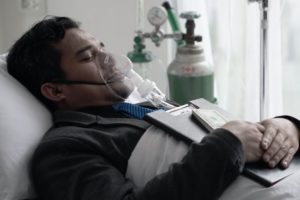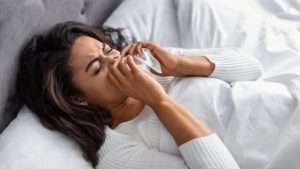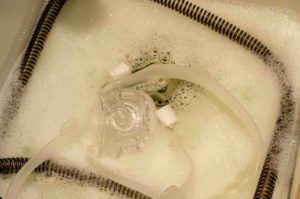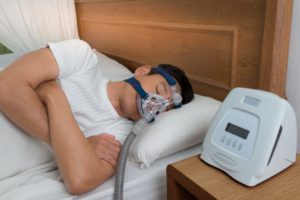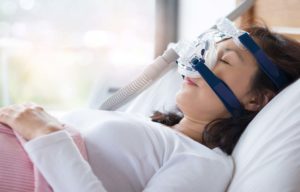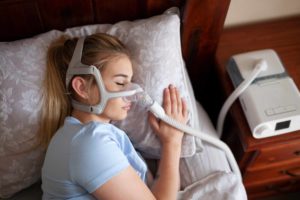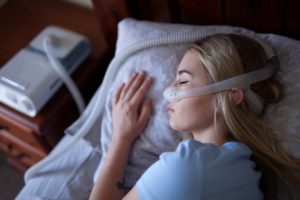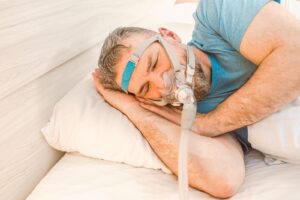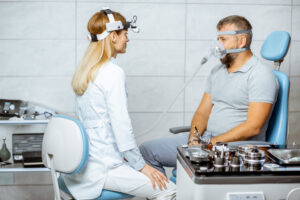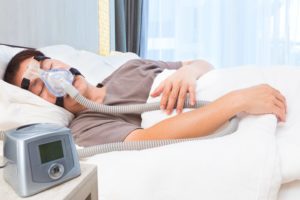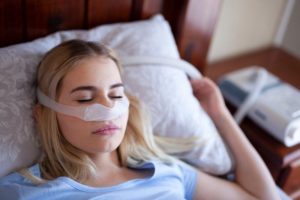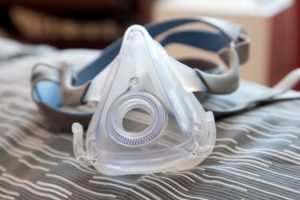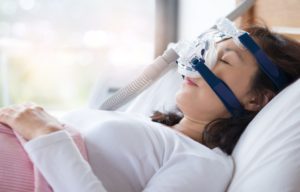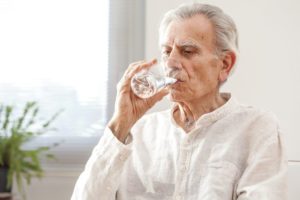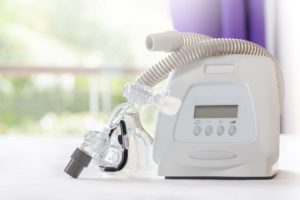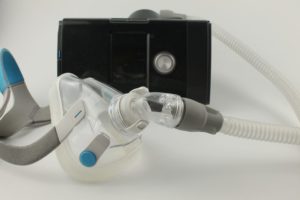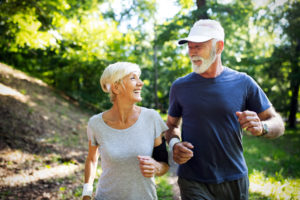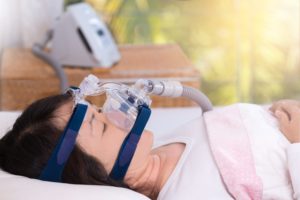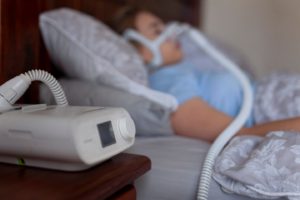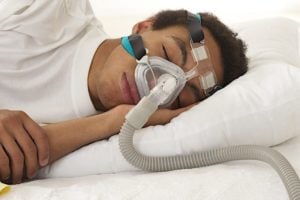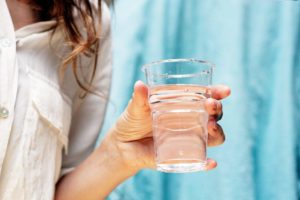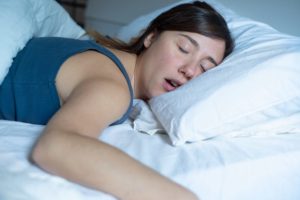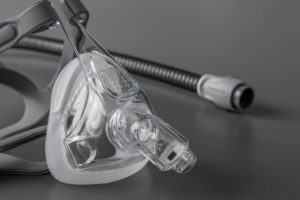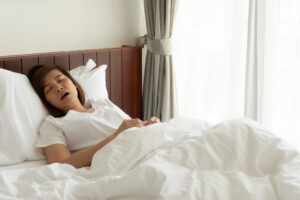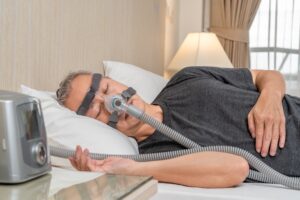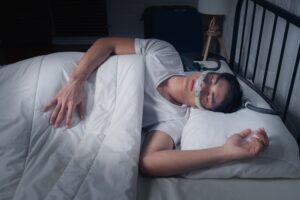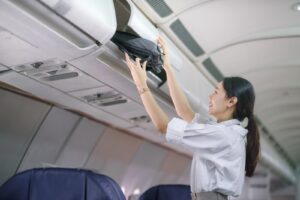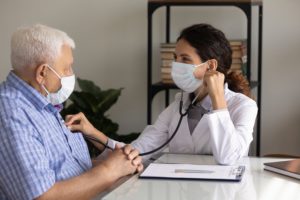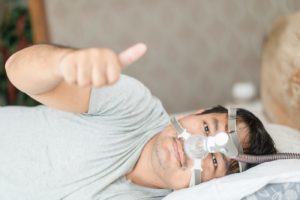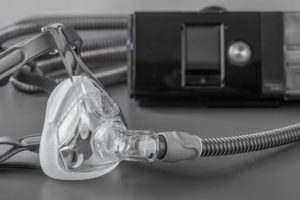When you buy through our links, we may earn a commission. Products or services may be offered by an affiliated entity. Learn more.
What Is a BiPAP Machine?
A bilevel positive airway pressure (BiPAP or BPAP) machine normalizes breathing by delivering pressurized air into the upper airway that leads to the lungs. A BiPAP machine is one type of positive airway pressure (PAP) device. PAP therapy is frequently used to treat sleep apnea, a condition involving repeated pauses or disruptions in breathing during sleep.
Another type of PAP machine called a continuous positive airway pressure (CPAP) is widely used as an initial treatment for obstructive sleep apnea (OSA). OSA is the most common type of sleep apnea, affecting 10% to 30% of American adults. However, CPAP is not for everyone.
Knowing how BiPAP machines work and when they are used can help people with sleep apnea or other breathing problems understand their treatment options. Learning more about these machines can also help people weigh the potential benefits and downsides of BiPAP therapy.

Exploring CPAP Machines — But Haven’t Been Tested Yet?
Start with our easy, at-home sleep test. It’s stress-free and effective. Get results within a few days.
How BiPAP Machines Work
BiPAP machines work by sending a stream of pressurized air from the device into the upper airway through an attached hose and mask. Its bilevel design means that a BiPAP device provides two different levels of air pressure: one for breathing in and one for breathing out.
- IPAP: Inspiratory positive airway pressure (IPAP) is the pressure level when breathing in.
- EPAP: Expiratory positive airway pressure (EPAP) is the pressure level when breathing out.
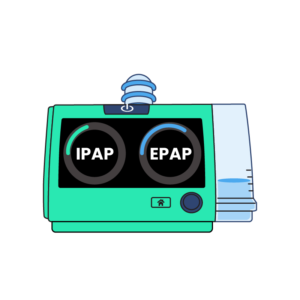

Typically, the air pressure for inhalation is higher than it is for exhalation. The stream of pressurized air prevents the tissue around the upper airway from collapsing and blocking the airway. In this way, BiPAP therapy can help prevent breathing disruptions, snoring, and unwanted awakenings .
A BiPAP machine can also be programmed to deliver air at regular intervals or if a person’s breathing becomes too shallow. This function allows BiPAP to facilitate more regular breathing in people who have health conditions that can cause slow or inconsistent respiration.
BiPAP and Other Types of PAP Therapy
In addition to BiPAP, various other positive airway pressure machines are available that utilize different technologies to improve breathing during sleep. It may be helpful to learn about and compare options for PAP therapy with your doctor or sleep specialist. They can recommend the appropriate machine based on a person’s specific condition.
BiPAP vs. CPAP
A BiPAP machine provides air at two different pressure levels, one for breathing in and one for breathing out. By contrast, a CPAP machine pumps air at a consistent level of pressure regardless of whether a person is inhaling or exhaling.
For obstructive sleep apnea, CPAP is used more often than BiPAP as an initial treatment unless a person has other breathing difficulties in addition to OSA. BiPAP may be recommended over CPAP for people who have more complicated breathing disorders or when CPAP treatment is not effective in treating OSA. BiPAPs may also be preferred by people who find it difficult or uncomfortable to exhale when using a CPAP.
In recent years, new CPAP machine designs have reduced the differences between CPAP and BiPAP therapy. Many CPAPs available today have a feature, often called pressure relief, that allows for mild decreases in air pressure when a person breathes out.
BiPAP vs. APAP
APAP stands for auto-adjusting positive airway pressure. An APAP machine works like a CPAP, except that the device is programmed with software that monitors for breathing disruptions and adjusts air pressure levels accordingly. While certain BiPAP devices also provide this auto-adjusting feature, many operate with preset air pressure levels.
Like CPAPs, auto-adjusting devices are more commonly used than BiPAP in the initial treatment of obstructive sleep apnea. Doctors typically only suggest BiPAP when APAP or CPAP therapy has not resolved OSA or when a person’s breathing disruptions are more complicated.
BiPAP vs. ASV
Both BiPAP and adaptive servo-ventilation (ASV) machines provide air pressure at two distinct levels when breathing in and out, but ASV devices use an algorithm to make real-time adjustments to the amount of air pressure.
Some BiPAP models are auto-adjusting and can also modify air pressure levels in direct response to a person’s breathing. These devices, sometimes called auto-BiPAPs, are similar to ASV but may have different features and algorithms.
ASV is rarely used by people with obstructive sleep apnea unless they also have other complex breathing problems. ASV, like BiPAP, is most often recommended for people with central sleep apnea and other breathing disorders.
Who Should Use a BiPAP Machine?
BiPAP machines have a range of potential uses, including for some cases of obstructive sleep apnea, many other sleep-related breathing disorders, and certain respiratory problems. Decisions about who should use a BiPAP should always be made in consultation with a doctor or sleep specialist.
BiPAP Treatment for Obstructive Sleep Apnea
BiPAP therapy is typically only prescribed for people with OSA in specific circumstances:
- High pressure requirements: When high levels of air pressure during inhalation are needed to prevent breathing lapses, doctors may recommend a BiPAP instead of a CPAP or APAP.
- Unsuccessful treatment with CPAP: If initial therapy with a CPAP does not solve breathing and sleep disruptions, a doctor may suggest that the patient switch to a BiPAP machine.
- Intolerance of CPAP inspiratory pressure: Exhaling against the incoming air pressure from a CPAP may be bothersome and cause a person to stop using the device. In this case, a BiPAP may offer more comfort and encourage consistent use of PAP therapy.
- Coexisting breathing problems: BiPAP machines can provide breathing support to people whose OSA is more complicated because they also have another breathing condition, such as central sleep apnea.
BiPAP Therapy for Other Sleep-Related Breathing Problems
Doctors and sleep specialists may recommend BiPAP for central sleep apnea (CSA), a breathing condition that occurs in fewer than 1% of people. CSA is usually tied to other health conditions that cause breathing to be either too fast and deep, known as hyperventilation, or too slow or shallow, which is called hypoventilation. BiPAP machines can be programmed to help normalize breathing during sleep in people with these conditions.
Other breathing conditions that are associated with hypoventilation, like obesity hypoventilation syndrome (OHS) and chronic obstructive pulmonary disease (COPD) , can be treated with BiPAP therapy.
For conditions linked to hyperventilation, BiPAP machines are generally used only after another type of PAP therapy has been tried. Examples of conditions that can cause hyperventilation-related CSA include:
- Heart failure, in which the heart is too weak or functioning abnormally and unable to pump enough blood to other parts of the body
- Cheyne-Stokes breathing, which is breathing that cycles between being too fast and too slow
- High-altitude periodic breathing, which involves faster breathing mixed with breathing lapses after arriving at a location at high elevation
It is not uncommon for people to have more than one of these breathing disorders. A doctor will recommend medical care, including BiPAP or other therapies, based on each person’s specific situation.
Using BiPAP Machines for COVID-19
BiPAP machines and other types of PAP devices can help breathing become more consistent. This may benefit some people whose lung function is significantly affected by COVID-19 . In these cases, BiPAP helps address a major complication of COVID-19, but it is not a treatment for the virus itself.
When used in this way, BiPAP serves as a type of therapy called noninvasive respiratory support, noninvasive positive pressure ventilation, or noninvasive ventilation . Noninvasive approaches are alternatives to intubation and mechanical ventilators.
In addition to COVID-19, BiPAP and other types of noninvasive ventilation may be recommended for people who have acute difficulty breathing, such as those with chronic obstructive pulmonary disease, a condition of damaged, inflamed, or clogged airways.
Potential Side Effects of BiPAP Therapy
New users of BiPAP machines often see short-term issues. They may go away on their own or after making adjustments to the mask or the BiPAP device settings. Side effects, similar to those from other types of PAP therapy, may include:
- Dryness in the mouth, nose, or throat
- Nasal congestion or a runny nose
- Discomfort when wearing the mask
- Skin irritation, especially around the area covered by the mask
- Disturbance from noise produced by the machine
- Claustrophobia when wearing the mask
BiPAP machines can also be expensive, especially relative to CPAPs, which may be a barrier for people who have to pay for the device out of pocket. Additionally, because a BiPAP reduces the air pressure when a person breathes out, it is possible for the pressure to be too low to improve sleep apnea. The configuration of the BiPAP’s settings should be designed to decrease the chances of this occurring and only adjusted by your doctor.
BiPAP Machine Components and Configuration
A BiPAP machine has several different components, which are similar to those found in other PAP devices.
- Machine: The actual device is responsible for pressurizing the air. A digital interface typically provides information about how the device is working.
- Hose: A tube or hose attaches to the BiPAP machine at one end and carries air to the mask, which connects to the other end.
- Mask: The mask delivers air through the nose, mouth, or nose and mouth, while creating a seal against the face. Users may need to try different types or shapes of masks to find one that works well and is comfortable.
- Filter: One or more filters usually sit inside the device to help decontaminate the air being sent through the hose.
- Humidifier: BiPAPs frequently have an attached water reservoir, which provides heated humidification to the air as it passes through the hose and mask.
Setting up a BiPAP machine involves determining the proper air pressure levels for the person using the machine and selecting the device’s mode of operation. Whether for obstructive sleep apnea or central sleep apnea, the goal of BiPAP configuration is to establish settings that resolve breathing disruptions.
Fixed BiPAP vs. Auto-BiPAP
The amount of air pressure delivered for BiPAP therapy depends on whether the device uses fixed or auto-adjusting settings.
- Fixed BiPAP: For a fixed BiPAP, the pressure levels for both inhalation and exhalation are preset in the device settings and do not change during the night.
- Auto-adjusting BiPAP: With this type of machine, the levels of air pressure can change through the night in response to a person’s breathing patterns.
While auto-adjusting BiPAP machines feature innovative algorithms to dynamically adapt pressure levels, they have not been studied as extensively as fixed BiPAP machines. More research will be needed to fully compare the risks and benefits of these two types of BiPAP.
Initial BiPAP Air Pressure Settings
Depending on a person’s breathing needs, BiPAP machines can be set up to function in one of three different modes.
- Timed mode (T): In timed mode, the machine pumps air according to a set schedule aligned with a person’s breathing rate.
- Spontaneous mode (S): In this mode, the machine only pumps air when the user takes a breath in or lets a breath out.
- Spontaneous timed mode (S/T): In this combination mode, the BiPAP device delivers air when a person breathes in or out, but it can also deliver a “back-up breath” if it does not detect breathing within a certain period of time.
Pressure settings are established for fixed BiPAP machines through an in-lab titration. Sleep specialists have more experience with this type of titration, so many experts prefer that BiPAP pressure levels be calibrated during a sleep study.
Even for auto-adjusting devices, many doctors recommend an in-lab titration during a sleep study to determine a range of pressure levels for the specific patient. However, in-home calibration may be offered for auto-adjusting BiPAP devices that have sensors to monitor breathing and built-in software to determine pressure levels.
After an in-home titration, the user may need to follow up with their doctor or sleep specialist to check the device’s settings. Health care providers may also want to confirm the effectiveness of the settings in an overnight sleep study.
How to Use a BiPAP Machine
The doctor or sleep specialist who prescribes a BiPAP machine typically offers directions for using it. In addition, the machine should come with an instruction manual that gives details about operating the device.
It is important to carefully follow any directions for using a BiPAP that come from a health professional or the device manufacturer. The general steps for getting started using a BiPAP include:
1. Set up the device on a flat surface near the bed.
2. Hook up the hose to the device.
3. Attach the mask to the hose.
4. If your BiPAP has a humidifier, fill the reservoir with distilled water.
5. Plug in the BiPAP.
6. Turn on the device.
7. Put on the mask.
8. Position the mask on the face until there is no sound of air coming out of the mask, confirming a strong seal.
9. Adjust any straps to hold the mask comfortably in place.
10. Try to use the machine for the entire night.
11. After waking up, take off the mask and turn off the machine.
For many devices, fixed pressure settings will already be programmed into the machine. If an auto-adjusting device is being used, follow any instructions provided for its operation.
Tips for Getting Used to a BiPAP Machine
Sleeping while using a BiPAP machine can be a difficult adjustment for some people, but it usually gets easier after a few nights. Certain tips may help smooth the transition to nightly use of a BiPAP machine.
- Be patient and persistent: Although it can be frustrating at first, using the machine tends to get easier within a few days. Continuing to use the BiPAP throughout the night, even if it is a little bothersome, speeds up the process of getting acclimated to always using it.
- Practice while awake: It may help to wear the mask and turn on the air pressure for a brief, set period of time during the day. Using the device while watching TV or reading may make it easier to get used to the mask and flow of air.
- Experiment with different masks: A doctor or sleep specialist may recommend a mask, but it is normal to have to try out more than one before finding the most comfortable option that still makes a strong seal.
- Consider a pressure ramp: If it is hard to fall asleep with the full amount of prescribed air pressure, a ramp function may help. A pressure ramp starts with lower pressure and then gradually increases it over a period of up to 45 minutes.
- Establish routines for cleaning and maintenance: Regularly cleaning the machine and replacing components helps keep contaminated air out of the airway and lungs and ensure that the machine runs properly. Detailed maintenance instructions are generally included in the machine’s manual.
Talking With a Doctor
To get the full benefits of BiPAP therapy, a person should use their machine on a nightly basis. Any issues that hamper consistent use, such as discomfort or other side effects, should be discussed directly with a doctor or sleep specialist. In many cases, simple adjustments to the device or accessories can make it easier to sleep with a BiPAP.
It is also important to talk to a doctor if breathing difficulties or poor sleep continue despite BiPAP therapy. A BiPAP device collects data about breathing during sleep, and this information can help a doctor evaluate how well the therapy is working. Reviewing this data, along with any changes in symptoms, can help guide ongoing treatment for sleep-related breathing problems.

Still have questions? Ask our community!
Join our Sleep Care Community — a trusted hub of product specialists, sleep health professionals, and people just like you. Whether you’re searching for the perfect mattress or need expert sleep advice, we’ve got you covered. Get personalized guidance from the experts who know sleep best.
References
12 Sources
-
Kline, L. R. (2022, June 1). Clinical presentation and diagnosis of obstructive sleep apnea in adults. In N. Collop (Ed.). UpToDate.
https://www.uptodate.com/contents/clinical-presentation-and-diagnosis-of-obstructive-sleep-apnea-in-adults -
Brown, L. K., & Lee, W. (2022, August 25). Titration of positive airway pressure therapy for adults with obstructive sleep apnea. In N. Collop (Ed.). UpToDate.
https://www.uptodate.com/contents/titration-of-positive-airway-pressure-therapy-for-adults-with-obstructive-sleep-apnea -
Patil, S. P., Ayappa, I. A., Caples, S. M., Kimoff, R. J., Patel, S. R., & Harrod, C. G. (2019). Treatment of adult obstructive sleep apnea with positive airway pressure: An American Academy of Sleep Medicine clinical practice guideline. Journal of Clinical Sleep Medicine, 15(2), 335–343.
https://pubmed.ncbi.nlm.nih.gov/30736887/ -
Freedman, N., & Kuzniar T. J. (2021, March 4). Mode selection for titration of positive airway pressure in adults with obstructive sleep apnea. In S. M. Harding (Ed.). UpToDate.
https://www.uptodate.com/contents/mode-selection-for-titration-of-positive-airway-pressure-in-adults-with-obstructive-sleep-apnea -
Aurora, R. N., Bista, S. R., Casey, K. R., Chowdhuri, S., Kristo, D. A., Mallea, J. M., Ramar, K., Rowley, J. A., Zak, R. S., & Heald, J. L. (2016). Updated adaptive servo-ventilation recommendations for the 2012 AASM guideline: “The treatment of central sleep apnea syndromes in adults: Practice parameters with an evidence-based literature review and meta-analyses”. Journal of Clinical Sleep Medicine, 12(5), 757–761.
https://pubmed.ncbi.nlm.nih.gov/27092695/ -
Kuzniar T. J., & Freedman, N. (2022, April 7). Mode selection for positive airway pressure titration in adult patients with central sleep apnea syndromes. In S. M. Harding (Ed.). UpToDate.
https://www.uptodate.com/contents/mode-selection-for-positive-airway-pressure-titration-in-adult-patients-with-central-sleep-apnea-syndromes -
Becker, K. (2020, August 25). Central sleep apnea syndromes. Medscape.
https://emedicine.medscape.com/article/304967-overview#a6 -
Martin, T. J. (2022, May 20). Noninvasive positive airway pressure therapy for the obesity hypoventilation syndrome. In M. S. Badr (Ed.). UpToDate.
https://www.uptodate.com/contents/noninvasive-positive-airway-pressure-therapy-for-the-obesity-hypoventilation-syndrome -
Gay, P. C. (2021, November 19). Nocturnal ventilatory support in COPD. In J. K. Stoller (Ed.). UpToDate.
https://www.uptodate.com/contents/nocturnal-ventilatory-support-in-copd -
Badr, M. S. (2021, September 29). Central sleep apnea: Treatment. In N. Collop (Ed.). UpToDate.
https://www.uptodate.com/contents/central-sleep-apnea-treatment -
Anesi, G. L. (2022, July 11). COVID-19: Respiratory care of the nonintubated hypoxemic adult (supplemental oxygen, noninvasive ventilation, and intubation). In S. Manaker (Ed.). UpToDate.
https://www.uptodate.com/contents/covid-19-respiratory-care-of-the-nonintubated-hypoxemic-adult-supplemental-oxygen-noninvasive-ventilation-and-intubation -
Hyzy, R. C., & McSparron, J. I. (2022, July 29). Noninvasive ventilation in adults with acute respiratory failure: Benefits and contraindications. In P. E. Parsons (Ed.). UpToDate.
https://www.uptodate.com/contents/noninvasive-ventilation-in-adults-with-acute-respiratory-failure-benefits-and-contraindications


